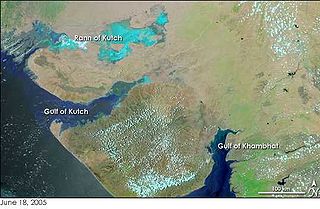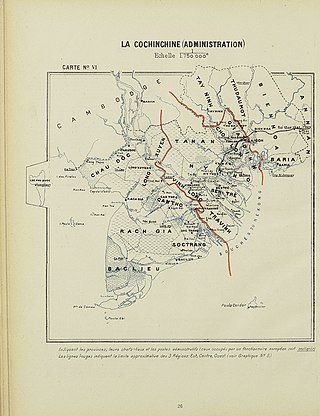Related Research Articles

Southeast Asia, also spelled South East Asia and South-East Asia, and also known as Southeastern Asia, South-eastern Asia or SEA, is the geographical south-eastern region of Asia, consisting of the regions that are situated south of mainland China, east of the Indian subcontinent, and north-west of mainland Australia which is part of Oceania. Southeast Asia is bordered to the north by East Asia, to the west by South Asia and the Bay of Bengal, to the east by Oceania and the Pacific Ocean, and to the south by Australia and the Indian Ocean. Apart from the British Indian Ocean Territory and two out of 26 atolls of Maldives in South Asia, Maritime Southeast Asia is the only other subregion of Asia that lies partly within the Southern Hemisphere. Mainland Southeast Asia is completely in the Northern Hemisphere. East Timor and the southern portion of Indonesia are the parts of Southeast Asia that lie south of the Equator.

The history of Southeast Asia covers the people of Southeast Asia from prehistory to the present in two distinct sub-regions: Mainland Southeast Asia and Maritime Southeast Asia. Mainland Southeast Asia comprises Cambodia, Laos, Myanmar, Peninsular Malaysia, Thailand and Vietnam whereas Maritime Southeast Asia comprises Brunei, Cocos (Keeling) Islands, Christmas Island, East Malaysia, East Timor, Indonesia, Philippines and Singapore.

A thalassocracy or thalattocracy, sometimes also maritime empire, is a state with primarily maritime realms, an empire at sea, or a seaborne empire. Traditional thalassocracies seldom dominate interiors, even in their home territories. Examples of this were the Phoenician states of Tyre, Sidon and Carthage; the Italian maritime republics of Venice and Genoa of the Mediterranean; the Chola dynasty of Tamil Nadu in India; the Omani Empire of Arabia; and the Austronesian empires of Srivijaya and Majapahit in Maritime Southeast Asia. Thalassocracies can thus be distinguished from traditional empires, where a state's territories, though possibly linked principally or solely by the sea lanes, generally extend into mainland interiors in a tellurocracy.

Srivijaya was a Buddhist thalassocratic empire based on the island of Sumatra, which influenced much of Southeast Asia. Srivijaya was an important centre for the expansion of Buddhism from the 7th to the 11th century AD. Srivijaya was the first polity to dominate much of western Maritime Southeast Asia. Due to its location, Srivijaya developed complex technology utilizing maritime resources. In addition, its economy became progressively reliant on the booming trade in the region, thus transforming it into a prestige goods-based economy.

The Javanese are an Austronesian ethnic group native to the central and eastern part of the Indonesian island of Java. With more than 100 million people, Javanese people are the largest ethnic group in both Indonesia and in Southeast Asia as a whole. Their native language is Javanese, it is the largest of the Austronesian languages in number of native speakers and also the largest regional language in Southeast Asia. The Javanese as the largest ethnic group in the region have dominated the historical, social, and political landscape in the past as well as in modern Indonesia and Southeast Asia.

The Malay Archipelago also called Insulindia or the Indo-Australian Archipelago is the archipelago between Mainland Southeast Asia and Australia. It has also been called the "Malay world," "Nusantara", "East Indies", and other names over time. The name was taken from the 19th-century European concept of a Malay race, later based on the distribution of Austronesian languages.

The spice trade involved historical civilizations in Asia, Northeast Africa and Europe. Spices such as cinnamon, cassia, cardamom, ginger, pepper, nutmeg, star anise, clove, and turmeric were known and used in antiquity and traded in the Eastern World. These spices found their way into the Near East before the beginning of the Christian era, with fantastic tales hiding their true sources.

Maritime Southeast Asia comprises the countries of Brunei, Indonesia, Malaysia, the Philippines, Singapore, and East Timor.

Greater India, also known as the Indian cultural sphere, the Indosphere, or the Indic world, is an area composed of many countries and regions in South and Southeast Asia that were historically influenced by Indian culture, which itself formed from the various distinct indigenous cultures of these regions. Specifically Southeast Asian influence on early India had lasting impacts on the formation of Hinduism and Indian mythology. Hinduism itself formed from various distinct folk religions, which merged during the Vedic and subsequent periods. The term Greater India, as a reference to the Indian cultural sphere, was popularised by a network of Bengali scholars in the 1920s. It is an umbrella term encompassing the Indian subcontinent and surrounding countries, which are culturally linked through a diverse cultural cline. These countries have been transformed to varying degrees by the acceptance and introduction of cultural and institutional elements from each other. Since around 500 BCE, Asia's expanding land and maritime trade had resulted in prolonged socio-economic and cultural stimulation and diffusion of Hindu and Buddhist beliefs into the region's cosmology, in particular in Southeast Asia and Sri Lanka. In Central Asia, the transmission of ideas was predominantly of a religious nature.

Indian maritime history begins during the 3rd millennium BCE when inhabitants of the Indus Valley initiated maritime trading contact with Mesopotamia. As per Vedic records, Indian traders and merchants traded with the far east and Arabia. During the Maurya Empire, there was a definite "naval department" to supervise the ships and trade. At the end of 1st century BCE Indian products reached the Romans during the rule of Augustus, and the Roman historian Strabo mentions an increase in Roman trade with India following the Roman annexation of Egypt. As trade between India and the Greco-Roman world increased, spices became the main import from India to the Western world, bypassing silk and other commodities. Indians were present in Alexandria while Christian and Jewish settlers from Rome continued to live in India long after the fall of the Roman Empire, which resulted in Rome's loss of the Red Sea ports, previously used to secure trade with India by the Greco-Roman world since the Ptolemaic dynasty. The Indian commercial connection with Southeast Asia proved vital to the merchants of Arabia and Persia during the 7th–8th century. A study published in 2013 found that some 11 percent of Australian Aboriginal DNA is of Indian origin and suggests these immigrants arrived about 4,000 years ago, possibly at the same time dingoes first arrived in Australia.
Anthony Reid is a New Zealand-born historian of Southeast Asia. His doctoral work at Cambridge University examined the contest for power in northern Sumatra, Indonesia in the late 19th century, and he extended this study into a book The Blood of the People on the national and social revolutions in that region 1945–49. He is most well known for his two volume book "Southeast Asia in the Age of Commerce", developed during his time at the Research School of Pacific Studies, Australian National University in Canberra. His later work includes a return to Sumatra where he explored the historical basis for the separate identity of Aceh; interests in nationalism, Chinese diaspora and economic history, and latterly the relation between geology and deep history.

Nihonmachi is a term used to refer to historical Japanese communities in Southeast and East Asia. The term has come to also be applied to several modern-day communities, though most of these are called simply "Japantown", in imitation of the common term "Chinatown".

The General Crisis is a term used by some historians to describe an alleged period of widespread regional conflict and instability that occurred from the early 17th century to the early 18th century in Europe, and in more recent historiography in the world at large.

Kampuchea Krom is the region variously known as Southern Vietnam, Nam Bo, and the former French Cochinchina. Bordering present-day Cambodia, the region is positioned in Cambodian nationalist mythology as a "once-integral part of the Khmer kingdom that was colonised by France as Cochinchina in the mid-nineteenth century, then was ceded to Vietnam in June 1949". In the present day, the region roughly corresponds to the Mekong Delta region of Vietnam.

Southeast Asia was in the Indian sphere of cultural influence from 290 BCE to the 15th century CE, when Hindu-Buddhist influences were incorporated into local political systems. Kingdoms in the southeast coast of the Indian Subcontinent had established trade, cultural and political relations with Southeast Asian kingdoms in Burma, Bhutan, Sri Lanka, Thailand, the Sunda Islands, Malay Peninsula, Philippines, Cambodia, Laos, and Champa. This led to the Indianisation and Sanskritisation of Southeast Asia within the Indosphere, Southeast Asian polities were the Indianised Hindu-Buddhist Mandala.

Vietnam under Chinese rule or Bắc thuộc refers to four historical periods when several portions of modern-day Northern Vietnam was under the rule of various Chinese dynasties. Bắc thuộc in Vietnamese historiography is traditionally considered to have started in 111 BC, when the Han dynasty conquered Nanyue and lasted until 939, when the Ngô dynasty was founded. A fourth, relatively brief, 20-year rule by the Ming dynasty during the 15th century is usually excluded by historians in their discussion of the main, almost continuous, period of Chinese rule from 111 BC to 939 AD.
The Makassar kingdom of Gowa emerged around 1300 CE as one of many agrarian chiefdoms in the Indonesian peninsula of South Sulawesi. From the sixteenth century onward, Gowa and its coastal ally Talloq became the first powers to dominate most of the peninsula, following wide-ranging administrative and military reforms, including the creation of the first bureaucracy in South Sulawesi. The early history of the kingdom has been analyzed as an example of state formation.
The Indian influences in early Philippine polities, particularly the influence of the Srivijaya and Majapahit thalassocracies on cultural development, is a significant area of research for scholars of Philippine, Indonesian, and Southeast Asian history, and is believed to be the source of Hindu and Buddhist elements in early Philippine culture, religion, and language. Because the Indonesian thalassocracies of Srivijaya and Majapahit acquired many of these Hindu and Buddhist elements through Indianization, the introduction of such elements to early Philippine cultures has sometimes been referred to as indianization. In more recent scholarship, it is termed localization, as in, e.g., localization of Hindu and Buddhist beliefs. Some scholars also place the Philippine archipelago within the outermost reaches of the Indosphere, along with Northern Vietnam, where the Hindu and Buddhist elements were not directly introduced by Indian travellers.

Ghurab or gurab is a type of merchant and warship from the Nusantara archipelago. The ship was a result of Mediterranean influences in the region, particularly introduced by the Arabs, Persians, and Ottomans. For their war fleet, the Malays prefer to use shallow draught, oared longships similar to the galley, such as lancaran, penjajap, and kelulus. This is very different from the Javanese who prefer long-range, deep-draught round ships such as jong and malangbang. The reason for this difference is that the Malays operated their ships in riverine water, sheltered straits zone, and archipelagic environment, while the Javanese are often active in the open and high sea. After contact with Iberian people, both the Javanese and Malay fleets began to use the ghurab and ghali more frequently.
André Wink is an emeritus professor of history at University of Wisconsin, Madison. He is known for his studies on India and the Indian Ocean area, particularly over the medieval and early modern age. He is the author of a series of books published by Brill Academic, Oxford University Press, and Cambridge University Press on al-Hind – a term used in Arab history to refer to the Islamized regions in the Indian subcontinent and nearby regions.
References
- ↑ New York Review of BooksFeb 16, 1989
- ↑ All Asia Review of Books June 1989
- ↑ ASAA Review 12: 3 (1989)
- ↑ Journal of Asian Studies 54:3 (Aug.1995) and Strange Parallels: Southeast Asia in Global Context, c.800-1830, Vol. I (Cambridge University Press, 2003) 15-21
- ↑ "Anthony REID". Fukuoka Prize. Retrieved 23 October 2023.